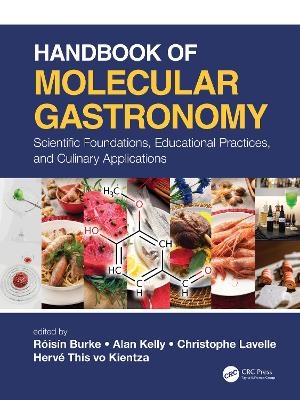
Handbook of Molecular Gastronomy
Crc Press Inc (Verlag)
978-1-4665-9478-4 (ISBN)
Features:
Gives A–Z coverage to the underlying science (physics, chemistry and biology) and technology, as well as all the key cooking issues (ingredients, tools and methods).
Encompasses the science and practice of molecular gastronomy in the most accessible and up-to-date reference available.
Contains a final section with unique recipes by famous chefs.
The book is organized in three parts. The first and main part is about the scientific discipline of molecular and physical gastronomy; it is organized as an encyclopedia, with entries in alphabetical order, gathering the contributions of more than 100 authors, all leading scientists in food sciences, providing a broad overview of the most recent research in molecular gastronomy. The second part addresses educational applications of molecular gastronomy, from primary schools to universities. The third part provides some innovative recipes by chefs from various parts of the world.
The authors have made a particular pedagogical effort in proposing several educational levels, from elementary introduction to deep scientific formalism, in order to satisfy the broadest possible audience (scientists and non-scientists). This new resource should be very useful to food scientists and chefs, as well as food and culinary science students and all lay people interested in gastronomy.
Christophe Lavelle, Herve This, Alan L. Kelly, Roisin Burke
Introduction
Part I Scientific Foundations
Acids in Foods and Perception of Sourness
Anthocyanins in Food
Alcoholic Beverages: Production, Trends, Innovations
Ash in the Kitchen
Baking: Laminated Bakery Products
Baking: Chemical Leaveners
Baking: Injera – the Multi- Eyed Flat Bread
Baking: Viennoiserie – Laminated Pastry Production
Baking: How Does Starch Gelatinization Influence Texture?
Baking: Sourdough Bread
Barbecue: The Chemistry behind Cooking on a Barbecue
Bioactivity and Its Measurement
Browning: The Glycation and Maillard Reactions – Major Non- Enzymatic Browning Reactions in Food
Canning: Appert and Food Canning
Capillarity in Action
Champagne Tasting from a Scientific Perspective
Chantillys: The Cousins of Whipped Cream
Cheese: Hot Culinary Uses of Cheese
Chocolate: Chocolates from around the World, Simple Physics, Complex Flavour
Chocolate: Oral Processing of Chocolate – Successive Interplay of Sensory and Physicochemical Parameters
Coffee Preparation – from Roasted Beans to Beverage
Colour: Natural Pigments in Foods and Their Technical Uses
Cooking
Cooking: Culinary Precisions and Robustness of Recipes
Cryogenics in the Kitchen
Dairy: Milk Gels – a Gastrophysics View
Dairy: Culinary Uses of Milk, Butter and Ice Cream
Dairy: Ginger Milk Curd
Dehydration
Dispersed System Formalism
Distillation: The Behaviour of Volatile Compounds during Distillation of Hydro- Alcoholic Solutions and during Hydro- DistillationEggs: Let Us Have an Egg
Emulsions: Emulsified Systems in Food
Emulsions and Foams: Ostwald Ripening and Disproportionation in Practice
Emulsions: Lecithin
Emulsions: Emulsions and Surfactants in the Kitchen
Essential Oils
Essential Oils: How to Safely Use Essential Oils
Evaporation
Expansion
Fats and Oils: Physicochemical Properties of Edible Oils and Fats
Fats and Oils: From Fat Droplets in Plant Seeds to Novel Foods
Fats and Oils: Oxidation of Dietary Lipids
Fats and Oils: Extra Virgin Olive Oil in Cooking – Molecular Keys for Traditional and Modern Mediterranean Gastronomy
Fermentation: Kimchi
Fermentation: Fermenting Flavours with Yeast
Fermentation: A Short Scientific and Culinary Overview of Kefir
Filtration Membranes for Food Processing and Fractionation
Food Matrices and Matrix Effect in the Kitchen
Food Pairing: Is It Really about Science?
Freeze- Drying
Foams: Pickering Edible Oil Foam – Toward New Food Products
Frying
Gastrophysics: A New Scientific Approach to Eating
Gels
Heat Transfer in Culinary Sciences
Hydrocolloid Usages as Gelling and Emulsifying Agents for Culinary and Industrial Applications
Imaging Foodstuffs and Products of Culinary Transformations
Meat: Meat Tenderness and the Impact of Cooking
Meat: Heat Transfer in Meat
Meat: Reduction of Nitrate and Nitrite Salts in Meat Products – What Are the Consequences and Possible Solutions?
Microwave Heating and Modern Cuisine
Mineral Ions and Cooking
Osmosis in the Kitchen
Pasta: Durum Wheat Proteins – a Key Macronutrient for Pasta Qualities
Pasteurization in the Kitchen
Plating: The Science of Plating
Proteins and Proteases
Puddings: The Secret of the Rice Pudding
Roasting
Salt: When Should Salt Be Added to Meat Being Grilled?
Sauces
Sauces: Hollandaise Sauce
Sauces and Purées: The Underside of Applesauce
Seaweeds: Phycogastronomy – the Culinary Science of Seaweeds
Size Reduction
Smoked Foods
Sous Vide Cooking
Spherification
Squid: Gastrophysics of Squid – from Gastronomy to Science and back again
Sugars: Soft Caramel and Sucre à la Crème – an Undergraduate Experiment about Sugar Crystallization
Sugars: Sugar (and Its Substitutes) in Pastries
Sugars: Erythritol– Sucrose Mixtures out of Equilibrium – Exciting Thermodynamics in the Mouth
Sugars: Intramolecular Dehydration of Hexoses
Taste and Sound
Temporal Domination of Sensation: When Building Dishes, Let’s Take Temporality into Account
Texture: The Physics of Mouthfeel – Spreadable Food and Inulin Particle Gels
Texture: How Texture Makes Flavour
Texture: Tsukemono – the Art and Science of Preparing Crunchy Vegetables
Thickeners: Cellulose and Its Derivatives
3D Printing of Food
Umami: The Molecular Science of Umami Synergy
Part II Educational Practices
The Right Words for Improving Communication in Food Science, Food Technology, and between Food Science and Technology and a Broader Audience
Experimental Flavour Workshops
Teaching Argumentation and Inquiry through Culinary Claims
Cooking and Science Workshops: The "Soft of the World", Gelling Agents
Culinary Sciences for the Enhancement of the Public Understanding of Science
"Science and Cooking Activities" for Secondary School Students
How to Reduce Oil in French Fries: A Student Experiment
An Educational Satellite Project around the Scientific Elucidation of Culinary Precisions in Lebanon and in the Middle East
Bon Appétit, Marie Curie! A Stanford University Introductory Science of Cooking Course
Molecular Gastronomy in Science Education and Science Communication at the National University of Singapore
Molecular Gastronomy: A Universal Portal to the Molecular Sciences
Heat Transfer in the Kitchen – Exercises
Ionic Diffusion in Spherified Calcium Alginate Gels: A Laboratory Experiment
Simple Calculations Based on Cooking
Teaching and Cooking with Culinary Teachers
The Monthly INRAE- AgroParisTech Seminars on Molecular Gastronomy
Part III Culinary Applications
New Greek Cuisine
3D Printed Note by Note Recipe: Soya Lobster Prototype
Cooking (with) Olive Oil
Cooking for the Elderly
Culinary Constructivism and Note by Note Cooking
Decantation
Note by Note Recipes for a Press Conference and Tasting Organized at ITHQ, 2012
Using Liquid Nitrogen to Prepare Ice Creams in the Restaurant
A Note by Note Traditional Chinese Dinner Created and Served in Singapore
Greek Diracs
An Eclipse Dish
Modern Swiss Cooking
How Do Eggs Coagulate?
Vegetable Salad
Filtration
Waiter! There Is Garlic in My Meringue!
Lobster and Juniper
Molecular Cooking
Note by Note Cooking and Note by Note Cuisine
Spherification
The Raspberry Pear Viennoiserie
Molecular Mixology: Welcome Coffee, a Cocktail with Ten Layers
Cube of "Chicken- Carrot" with Chips of "Basil- Lemon"
Some of the Easiest Note by Note Recipes Served at Senses Restaurant
The Forest Floor
A Note by Note Macaron
Note by Note Cooking
Note by Note Sushis
Slowly Cooked Lamb Neck with Fermented Flour Pancakes, Sunchoke Puree and Beer Glaze
| Erscheinungsdatum | 10.06.2021 |
|---|---|
| Zusatzinfo | 71 Tables, black and white; 577 Halftones, color; 577 Illustrations, color |
| Verlagsort | Bosa Roca |
| Sprache | englisch |
| Maße | 210 x 280 mm |
| Gewicht | 1810 g |
| Themenwelt | Medizin / Pharmazie ► Gesundheitsfachberufe ► Diätassistenz / Ernährungsberatung |
| Naturwissenschaften ► Biologie | |
| Naturwissenschaften ► Physik / Astronomie ► Angewandte Physik | |
| ISBN-10 | 1-4665-9478-0 / 1466594780 |
| ISBN-13 | 978-1-4665-9478-4 / 9781466594784 |
| Zustand | Neuware |
| Haben Sie eine Frage zum Produkt? |
aus dem Bereich


